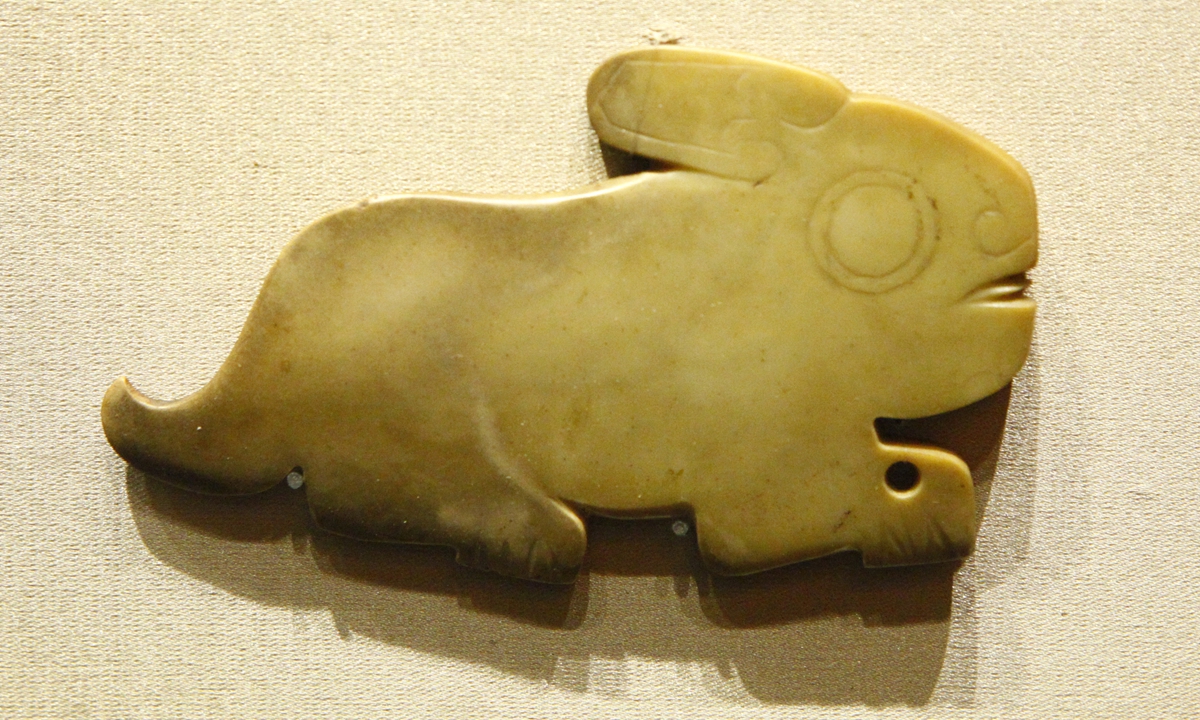
2022 Winter Olympic mascot Bing Dwen Dwen dressed as the Rabbit God Tu'er Ye Photo: VCG
Editor's Note:
As the Spring Festival, or Chinese New Year, approaches, the images of rabbits are appearing everywhere. In Chinese culture, the rabbit is not only a symbol of good luck, but also connected to longevity and fertility. Associated with the moon, the rabbit has appeared in numerous legends and classic literature works. In the following two issues, the Global Times will explore why Chinese people love this auspicious symbol and how it is staying relevant today.
When the last page of the calendar for the Year of the Tiger is torn down on January 22, the baton for 2023 will be passed down to the next member of the Chinese zodiac - the Rabbit. Naturally this leads to a rise in popularity for rabbit-themed art and products, including a new design for Bing Dwen Dwen, the Beijing Winter Olympic mascot. Inspired by the Year of the Rabbit, the cute panda is also getting all sorts of makeovers, such as a stamp designed by a fine art master that shows people's fondness for the Chinese zodiac.
As bells rang in the New Year over the past weekend, Beijing resident Wan Fang attempted to buy a doll of Bing Dwen Dwen dressed as Tu'er Ye, the Rabbit God, in Beijing's local folk culture, but she regrettably found that the zodiac-themed souvenir had already sold out just four days after its release.
From rabbit costumes to rabbit ears, these new designs on the 2022 Beijing Winter Olympic Games' mascot carry the distinctive characteristics of China's traditional culture as well as the best wishes for happiness and well-being in the New Year.
Seen on numerous ancient relics, the rabbit has been used since the dawn of Chinese culture as a symbol of best wishes for people's health, offspring and prosperity within a family.
To the moon
Looking at cultural relics discovered around the country, the rabbit has long been seen as an auspicious animal. For instance, there is the rabbit-shaped jade discovered in the Tomb of Fu Hao, wife of King Wu Ding of the Shang Dynasty (c.1600BC-1046BC).
Carved like it is running along the ground, the jade rabbit has a raised head and a slightly opened mouth.
The image of the rabbit started to be widely seen as ornaments or clothing patterns during the Han Dynasty (206BC-AD220), when worship of the sun and moon was all the rage, Chen Lüsheng, a renowned museologist and researcher at the National Museum of China, told the Global Times.

A jade rabbit discovered at the Shang Dynasty Tomb of Fu Hao Photo: VCG
A section of an exquisite painting on silk was unearthed from the Mawangdui Ruins Site, which contained the tombs of three people from the Han Dynasty Changsha Kingdom. At the top left corner of the painting, a rabbit and a toad standing on the moon can be seen.
"In the popular Han Dynasty folk tale, people thought that there were beasts on the sun and moon. The one on the moon is a rabbit called Yu Tu [Jade Rabbit], so the image of the rabbit has always accompanied the moon," Chen noted.
China's first moon rover, which landed on the moon at the end of 2013, was also named Yu Tu.
Chen pointed out that ancient Chinese had a kind of unique belief in a fabled goddess named Xiwangmu, who was a symbol of longevity, and since the moon represents the feminine in Chinese tradition, Xiwangmu is usually connected with the moon and the rabbit.
People living in the Han Dynasty also believed that immortality could be attained through prayer and medicine, so it was not unusually for ancient paintings or articles of clothing to feature rabbits grinding herbs with a mortar and pestle besides the goddess or on the moon. As time went on, the rabbit also gradually became a symbol of health and longevity.
Seeking blessings
As one dynasty replaced another, Chinese artists constantly added new auspicious meanings to the rabbit.
Pictures of three rabbits running and chasing each other in a clockwise or counterclockwise motion can be seen on architecture starting from the Sui Dynasty (581-618), especially in the murals from the Mogao Grottoes in Dunhuang, Northwest China's Gansu Province. Interestingly, each of the three rabbits has only one ear.
As zodiac culture grew more popular from the Song Dynasty (960-1279) to the Qing Dynasty (1644-1911), the rabbit appeared on different artworks more often, Huang Qingsui, a Zhuang ethnic art designer who created a database of all traditional Chinese patterns, told the Global Times.
Another popular design, a rabbit holding grass in its mouth, often appeared on porcelain produced during the Song Dynasty.
Huang said that these two depictions were taken as symbols representing the hope of having multiple children because of the strong fertility of rabbits, and so were very popular because having a lot of children was seen as one of best blessings.
URL: https://www.seeglobalnews.com/read-900.html